By Sean Fagan
.
7 Bomb-Proof Ways to Identify the Poisonous Fool’s Parsley
.
The committed bushcrafter is always expanding his or her knowledge of wild plants. It’s a never ending but deeply satisfying quest. When it comes to plants, bushcrafters are (amongst other titles) wild-food foragers, herbalists and botanists.
An unceasing, curious and methodical approach to nature is an attitude that every good bushcrafter must embrace. In a way, trying to know nature in all its dizzying complexity is an enormous challenge – but that’s where the bliss is - because getting to know nature is its own reward.
.
BREAKING THROUGH BARRIERS - OF THE BUSHCRAFT KIND
.
Occasionally, most serious bushcrafters will stumble upon an impasse in their endeavours. That impasse can be anything bushcraft-related – such as the bow drill, or tracking, or even differentiating between similar looking coniferous tree species.
Such is life - some things come easy, some things come with some effort. It’s important, on such occasions, to be philosophical and most importantly - to keep pushing forward.
Personally, whenever I have struggled with bushcraft projects I get well repaid by becoming very familiar with the subject matter. In fact, challenging projects can stir a higher level of intrigue that easier projects. Just my thoughts : )
.
THE CHALLENGE OF PLANT IDENTIFICATION
.
One common impasse for a lot of bushcrafters is plant identification. It’s not easy. Remembering all the different features of many plant species can be confusing. Still, its very much a matter of motivation and reward as to how far you want go towards building a decent list of plants that you know well and know how to use.
Plants are everywhere - most have mutiple culinary, medicinal and practical applications. They are a huge, fundamental part of bushcraft.
So what is the reward for memorising many different plant species and experimenting with them - bushcraft style?
Here is one answer: there is something deeply reassuring about venturing into a wild place and knowing at a glance all the different plants that surround you, and just as importantly - knowing which ones you can eat, make tea from, avoid, make rope from, use for shelter, which burns best as tinder, fuel etc.
Thats a great, liberating feeling. The woods or wherever you may be, have become one big step closer to a home.
One particular plant family, which has a paradoxical mix of edible and very poisonous species is the Apiceae (or Umbelliferae) plant family.
There's no easy way around identifying members of the Umbelliferae family (sometimes known as umbellifers). Time and attention to detail are required to get a firm grasp on the poisonous and edible umbellifer species. However, there is no need to get anxious about tackling umbellifers – because, when examined closely there are obvious differences between umbellifer species.
If you think umbellifers are not worth your time then consider the words of primitive survival expert, Tom Elpel. He describes umbellifers "among the most important family of plants to learn, since its includes some of the deadliest plants"(1).
Knowing the key characteristics of different umbellifer species will greatly improve your ability to steer clear of poisonous umbellifers. They are a plant family well worth knowing.
.
UMBELLIFERS = UMBRELLA
.
The Apiceae (or Umbelliferae) are a large family of plants (3,700 species) that contain both edible and poisonous species. One of the most recognisable characteristic of this plant group is the umbrella-like branching of the flower heads, whereby the multiple stalks of the flower head radiate from a single point from the main stem.
.
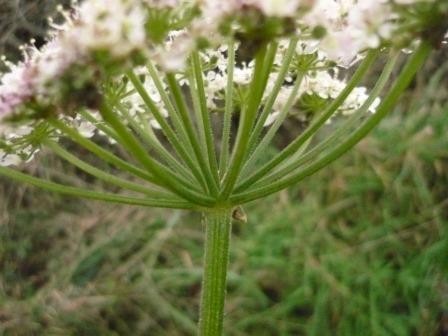
The flowers stems of this hogweed radiate from a single point on the main stem, which is a typical feature of all umbellifers (Photo: Sean Fagan).
.
This is a key feature of all umbellifers as there are some plant species that appear superficially like umbellifers. Yarrow, Achillies millifolium, appears like an umbellifer but is not. If you look closely - yarrow flower stalks radiate from multiple points along the main stalk, not from a single point on the main stem as is typical of all umbellifers.
The differences between toxic and edible umbellifers can be subtle. In addition there are quite a few umbellifer species. It’s very much a group of plants that requires time (and due diligence) in becoming competent at identifying the different species.
If you have a shred of doubt as regards identifying an umbellifer - DO NOT CONSUME THAT PLANT! The toxicity of some umbellifer species is so potent that they can cause serious illness or death.
One umbellifer that needs to be given a wide berth is fool’s parsley, Aethusa cynapium. This diminutive plant appears somewhat similar to a popular, tasty umbellifer: pignut, Conopodium majus. A clue to the toxicity of fool’s parsley is strongly indicated by some of its common names: dog poison, poison parsley and lesser hemlock.
BREAKING IT ALL DOWN - HOW TO EASILY IDENTIFY FOOL’S PARSLEY
.
The key identifying characteristics of fool’s parsley can be differentiated into 7 categories:. 1. Habitat 2. Height 3. Odour 4. Leaves 5. Seeds 6. Flowers 7. Stem
The above list of characteristics are a good starting point for remembering any umbellifer - and most plant species!
Remember, it’s not necessarily the individual features that are as important as the unique combination of features that positively identify a plant to species level.
I would recommend that you know at least 4-6 features (with an emphasis on unique or/and unusual features) of each umbellifers in your area to gain competency in identifying umbellifers.
.
7 CHARACTERISTICS OF FOOL’S PARLSEY
.
1. HABITAT: LIKES THE BRIGHTNESS OF OPEN SPACES!
Unlike the similar looking, woodland-dwelling pignut (Conopodium majus), fool’s parsley is a plant of open spaces. Found principally on the margins of arable land, waste land and disturbed ground – fool’s parsley favours the disturbed soil of open spaces where it gains a competitive advantage - by occupying a habitat with an abundance of light, space and few competitors.
2. HEIGHT: SHORT IN STATURE!
Fool’s parsley is a small umbellifer, reaching a lowly height of only 50cm, usually shorter. This is an important point as many common umbellifers are taller - sometimes conspicuously so. For example, giant hogweed, Heracleum mantegazzianum, can reach a monstrous height of 5 metres!
3. ODOUR: SMELLY!
Smell, is an important, but oft neglected identification feature of some plant species. Many plants have a distinctive odour which can be an aid in identification.
The foliage of fool’s parsley, when crushed, has an off-putting but not overwhelming odour.
Be careful with plant odours – whenever I’m with a group of people doing plant identification and I present a sample of an unpleasant smelling plant, most people will predictably dislike the odour.
Often there will be at least one individual that will actually like the odour. What makes an odour off-putting or pleasant is very much an individual preference.
4. LEAVES: PINNATE & TRIANGULAR
Pinnate, usually 2 or 3 times. Overall shape of leaf is somewhat triangular. Many umbellifers have pinnate leaves. Pinnate leaves are an important, plant identification feature as quite a few plants species, besides umbellifers, have pinnate leaves.
Best advice: get to know pinnate leaves!
Definition of pinnate: describing a leaf divided with opposite pairs of leaflets, with a terminal leaflet like a feather.
.
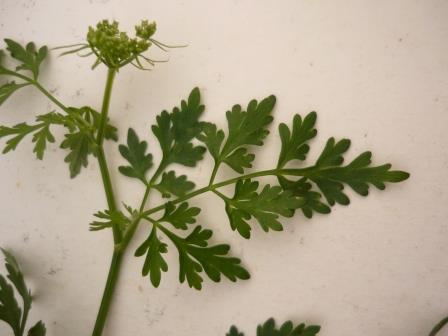
A finely divided, tri-pinnate leaf of fool's parsley. Note overall, triangular shape of leaf (photo: Sean Fagan)
.
5. SEEDS: LITTLE EGGS OF GROOVY GREEN
The seeds of fool’s parsley are a great, additional feature that reinforces positive identification of the plant. Tiny, egg-shaped and finely-grooved, the seed cases are very specific to fool’s parsley and well worth close examination, if present.
.
6. FLOWERS: WATCH THE BEARD!The miniscule, white flowers are arranged as a dense, somewhat flat cluster. Each flower has five petals.
The bracts that are attached to the underside of the flower head are especially diagnostic.
They occur in groups of 3-5 and are thin, pointed, sometimes curved and hang conspicuously from the underside of the flower head.
Another key feature is that they usually occur, beard-like, from one side of the flower head and are not uniformly distributed around the underside of the flower head.
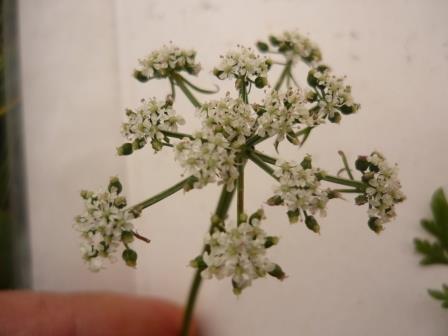
(Above) The tiny white flowers of fool's parsley. The distinct, hanging bracts are especially diagnostic of fool's parsley.
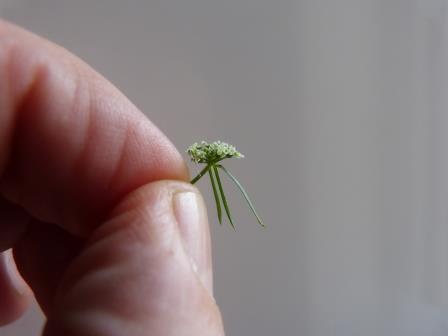
(Above) View of single flower head. Note beard of 3 long bracts hanging from one side of flowerhead (photo: Sean Fagan)
Uniformly green (generally no discoloration), finely grooved and mostly hollow.
The stem appears delicate but is surprisingly strong and stiff for its slight dimensions.
.
. So there you have it – 7 key characteristics of the harmful Fool’s Parsley- Habitat: open spaces, often disturbed soil.
- Height: short, sometimes reaching 50cm.
- Stem: green, finely ridged and slim.
- Flowers: white, tiny, 5-petaled with 3-5 hanging bracts on one side of flower head.
- Odour: unpleasant.
- Seeds: very small, egg-shaped and finely ridged.
- Leaves: two or three times pinnate, overall triangular in shape.
.
Getting to know poisonous and edible umbellifers will be an important milestone in honing your identification skills of plants.
In addition, umbellifers have a broad geographic distribution – occurring mostly in temperate regions of North America, Asia and Europe, so if you like to travel aboard to wild places in the Northern Hemisphere then getting to know umbelliers can add a reassuring note of familiarity to your wider travels.
Personally, I always enjoy coming across a familiar plant when aboard - whether it be a dandelion in a Canadian pasture or a patch of white clover along a forest edge in France, it’s always nice to catch up with old friends - so to speak.
Often, I have a source of nourishment, even medicine, at the end of my fingertips.
.
WHERE TO START?
.
Take your time in getting familiar with the Umbelliferae family. My basic advice is to thoroughly familiarise yourself with all the umbellifers in your locality.
Bring along a good plant identification guide. A small sketch book and/or camera is also a good idea for building up a visual record.
If you can solidly identify the following nine, mostly common umbellifers, you are well on the way to developing a good base of knowledge for the fascinating and diverse Umbelliferae family.
- HOGWEED Heracleum sphondylium
- ALEXANDERS Smyrnium olusatrum
- PIG NUT Conopodium majus
- WILD CARROT Daucus carota
- WILD ANGELICA Angelica sylvestris
- FOOL'S PARSLEY Aethusa cynapium (Poisonous)
- WATER DROPWORT HEMLOCK Oenanthe crocata (Poisonous)
- HEMLOCK Conium maculatum (Poisonous)
- GIANT HOGWEED Heracleum mantegazzianum (Poisonous)
.
Related articles on this website: *Check us out on Instagram, Twitter & Facebook for more outdoor-related topics..
References: Book: (1) Botany in a Day, Thomas J. Elpel (page 19)..
Pioneer Bushcraft
Disclaimer
The above article is offered as general advice. Pioneer bushcraft does not take any responsibility for any risks associated with incorrect plant identification.
It’s your responsibility, and your responsibility alone, to be thorough in your research on the edibility or toxicity of wild plants. Wild food foraging is not a subject to be taken lightly - it requires diligence and attention to detail.
Please, be careful. If you come across a wild plant which you're not sure is edible or poisonous – discard it!
IF IN DOUBT – LEAVE IT OUT!
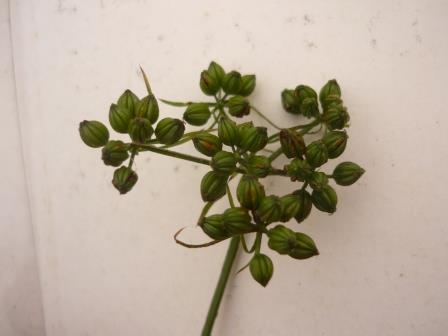
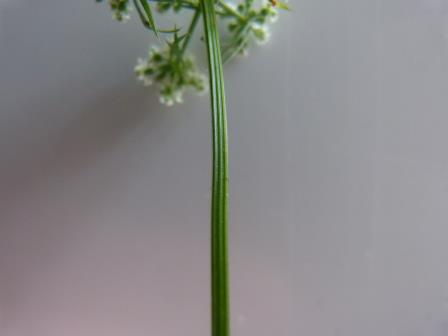

Recent Comments